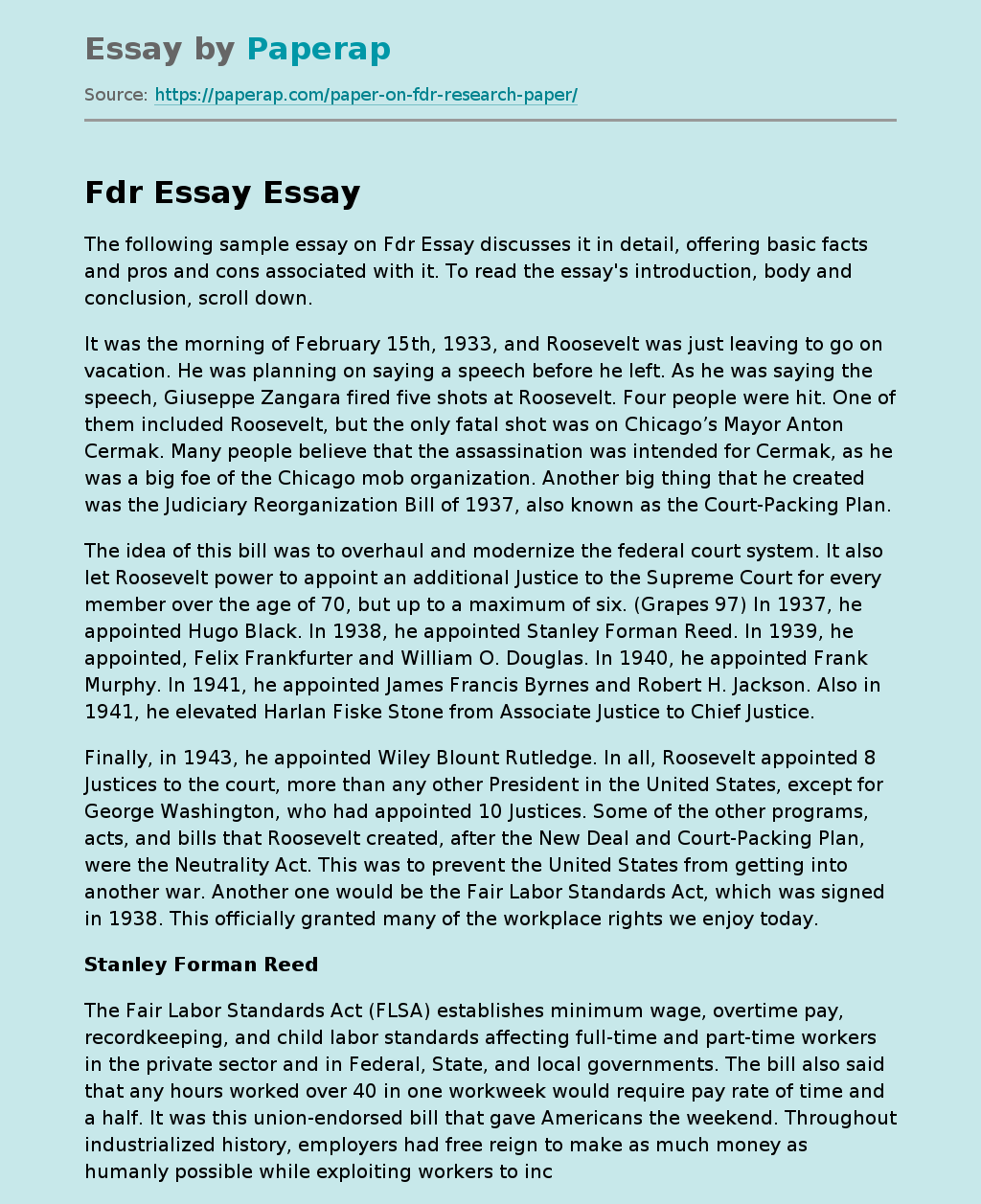The Bill on the Reorganization of the Judicial System in 1937
The following sample essay on The Bill on the Reorganization of the Judicial System in 1937 tells about the historical events of 1937, namely the Court-Packing Plan.
It was the morning of February 15th, 1933, and Roosevelt was just leaving to go on vacation. He was planning on saying a speech before he left. As he was saying the speech, Giuseppe Zangara fired five shots at Roosevelt. Four people were hit. One of them included Roosevelt, but the only fatal shot was on Chicago’s Mayor Anton Cermak.
Many people believe that the assassination was intended for Cermak, as he was a big foe of the Chicago mob organization. Another big thing that he created was the Judiciary Reorganization Bill of 1937, also known as the Court-Packing Plan.
The idea of this bill was to overhaul and modernize the federal court system. It also lets Roosevelt power to appoint an additional Justice to the Supreme Court for every member over the age of 70, but up to a maximum of six.
(Grapes 97) In 1937, he appointed Hugo Black. In 1938, he appointed Stanley Forman Reed. In 1939, he appointed, Felix Frankfurter and William O. Douglas. In 1940, he appointed Frank Murphy. In 1941, he appointed James Francis Byrnes and Robert H. Jackson. Also in 1941, he elevated Harlan Fiske Stone from Associate Justice to Chief Justice.
Finally, in 1943, he appointed Wiley Blount Rutledge. In all, Roosevelt appointed 8 Justices to the court, more than any other President in the United States, except for George Washington, who had appointed 10 Justices. Some of the other programs, acts, and bills that Roosevelt created, after the New Deal and Court-Packing Plan, where the Neutrality Act.
This was to prevent the United States from getting into another war. Another one would be the Fair Labor Standards Act, which was signed in 1938. This officially granted many of the workplace rights we enjoy today.
Stanley Forman Reed
The Fair Labor Standards Act (FLSA) establishes minimum wage, overtime pay, recordkeeping, and child labor standards affecting full-time and part-time workers in the private sector and in Federal, State, and local governments. The bill also said that any hours worked over 40 in one workweek would require a pay rate of time and a half. It was this union-endorsed bill that gave Americans the weekend. Throughout industrialized history, employers had free reign to make as much money as humanly possible while exploiting workers to increase their profits.
The FLSA established the minimum wage, overtime pay and child labor standards that we enjoy today. Roosevelt signed this bill into law, while in the middle of dealing with great pressure to save the nation from the Great Depression. He succeeded in establishing basic workers’ rights and setting the groundwork for a middle class that thrived after World War II. I think another important one would be the Selection Service Act. This act was signed by President Roosevelt on September 14, 1940.
This made it so that all men aged from 21-35 had to register with the local military draft boards, and all men 18-45 were able to be drawn to service, without volunteering. It would select men through a “lottery-like” system. When your name was drawn, you were automatically put in for 12 months of military service. One act, that was not so important, but helpful, was the Price Control Act. This made an Office of Price Administration. The Office of Price Administration was able to control and dictate all prices for nonagricultural items.
This helped to regulate the economy a little bit, and keeps from prices getting too high or even too low. A very important bill was the GI Bill of Rights. The formal name for this bill is the Servicemen’s Readjustment Act of 1944. This was a simple bill, but it changed and helped people’s lives. The main thing that this did was provide money, for military veterans, so they could go to college, after they got out of the military. It also provided guaranteed loans for homes, farms, or businesses, and it also gave unemployment pay for up to 52 weeks. (National Video Resources)
When FDR was in office, many well known war events happened. On December 7th, 1941, Japan bombed the United States Naval Base, Pearl Harbor, in Hawaii. Even though, Roosevelt signed the Neutrality Act, Congress was forced to declare war on Japan. Soon after this, Germany and Italy declared war on the U. S. During this time Hitler was performing the genocide of the Jews, also known as the Holocaust. Discussing how to surrender Nazi Germany, the “Big Three,” which included Winston Churchill, Franklin Delano Roosevelt, and Joseph Stalin, met at what was known at the Yalta meeting.
This took place on February 4th and ended on February 11th, on 1945. They also talked about other war strategies for the world to remain a peaceful country. Also United States, scientists found nuclear fission, which lead Albert Einstein to tell FDR that an atomic bomb was now possible. On June 6th, 1944, the twelve allied nations, which included Australia, Canada, Belgium, France, Czechoslovakia, Greece, New Zealand, the Netherlands, Norway, Poland, the United Kingdom, and the United States, invaded the beaches of Normandy in France, which started the liberation of countries under Nazi control.
All of these troops were led General Dwight D. Eisenhower. This day became known as D-Day. On November 7th, 1944, Roosevelt won the election, which was his fourth term. On March 29, 1945, Roosevelt went to Warm Springs, Georgia to rest. Then on an afternoon, on April 12th, Roosevelt said he had a pain in the back of his head, then fell forward and was unconscious. Franklin Delano Roosevelt died of a cerebral hemorrhage (stroke) at 3:35 P. M. (Wikimedia Foundation Inc. )
The Bill on the Reorganization of the Judicial System in 1937. (2019, Dec 06). Retrieved from https://paperap.com/paper-on-fdr-research-paper/

